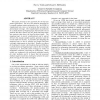Free Online Productivity Tools
i2Speak
i2Symbol
i2OCR
iTex2Img
iWeb2Print
iWeb2Shot
i2Type
iPdf2Split
iPdf2Merge
i2Bopomofo
i2Arabic
i2Style
i2Image
i2PDF
iLatex2Rtf
Sci2ools
108
Voted
VTS
1995
IEEE
1995
IEEE
Transformed pseudo-random patterns for BIST
This paper presents a new approach for on-chip test pattern generation. The set of test patterns generated by a pseudo-random pattern generator (e.g., an LFSR) is transformed into a new set of patterns that provides the desired fault coverage. The transformation is performed by a small amount of mapping logic that decodes sets of patterns that don’t detect any new faults and maps them into patterns that detect the hard-to-detect faults. The mapping logic is purely combinational and is placed between the pseudo-random pattern generator and the circuit under test (CUT). A procedure for designing the mapping logic so that it satisfies test length and fault coverage requirements is described. Results are shown for benchmark circuits which indicate that an LFSR plus a small amount of mapping logic reduces the test length required for a particular fault coverage by orders of magnitude compared with using an LFSR alone. These results are compared with previously published results for other...
Related Content
| Added | 26 Aug 2010 |
| Updated | 26 Aug 2010 |
| Type | Conference |
| Year | 1995 |
| Where | VTS |
| Authors | Nur A. Touba, Edward J. McCluskey |
Comments (0)

